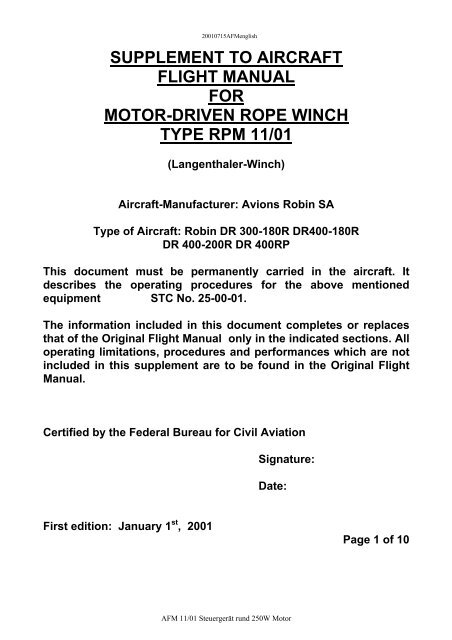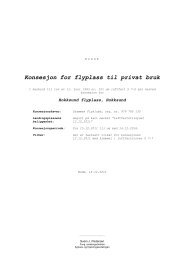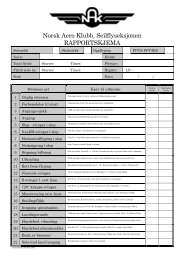SUPPLEMENT TO AIRCRAFT FLIGHT MANUAL FOR MOTOR ...
SUPPLEMENT TO AIRCRAFT FLIGHT MANUAL FOR MOTOR ...
SUPPLEMENT TO AIRCRAFT FLIGHT MANUAL FOR MOTOR ...
You also want an ePaper? Increase the reach of your titles
YUMPU automatically turns print PDFs into web optimized ePapers that Google loves.
20010715AFMenglish<br />
<strong>SUPPLEMENT</strong> <strong>TO</strong> <strong>AIRCRAFT</strong><br />
<strong>FLIGHT</strong> <strong>MANUAL</strong><br />
<strong>FOR</strong><br />
MO<strong>TO</strong>R-DRIVEN ROPE WINCH<br />
TYPE RPM 11/01<br />
(Langenthaler-Winch)<br />
Aircraft-Manufacturer: Avions Robin SA<br />
Type of Aircraft: Robin DR 300-180R DR400-180R<br />
DR 400-200R DR 400RP<br />
This document must be permanently carried in the aircraft. It<br />
describes the operating procedures for the above mentioned<br />
equipment STC No. 25-00-01.<br />
The information included in this document completes or replaces<br />
that of the Original Flight Manual only in the indicated sections. All<br />
operating limitations, procedures and performances which are not<br />
included in this supplement are to be found in the Original Flight<br />
Manual.<br />
Certified by the Federal Bureau for Civil Aviation<br />
Signature:<br />
Date:<br />
First edition: January 1 st , 2001<br />
Page 1 of 10<br />
AFM 11/01 Steuergerät rund 250W Motor
20010715AFMenglish<br />
<strong>SUPPLEMENT</strong> <strong>TO</strong> THE <strong>AIRCRAFT</strong> <strong>FLIGHT</strong> <strong>MANUAL</strong> RPM 11/01<br />
- 2 -<br />
I. GENERAL<br />
No changes from the Original Flight Manual<br />
II. OPERATING LIMITATIONS<br />
No changes from the Original Flight Manual<br />
III. EMERGENCY PROCEDURES<br />
REMARKS<br />
The emergency procedures during operation of the Aerazurhook<br />
remain unchanged from the Original Aircraft Flight Manual.<br />
The following remarks refer to the motor-driven rope winch only.<br />
3.1. DURING <strong>TO</strong>WING <strong>FLIGHT</strong><br />
3.1.1. EMERGENCY CUT-OFF<br />
In case of unusual attitude during towing flight caused by the sailplane, by<br />
malfunction of the hook on the sailplane or, in case of intenation due to other<br />
reasons, the following measures must be taken:<br />
CAUTION<br />
If the sailplane is too for above its<br />
normal position the towplane can be forced into an<br />
uncontrolled attitude!<br />
1. Emergency knife (yellow) PULL <strong>TO</strong> ITS LIMIT<br />
2. Rope winch DO NOT OPERATE<br />
The rope indicator will continue to show 100%, but the rope will have been cut. The<br />
subsequent landing can be carried out normally.<br />
AFM 11/01 Steuergerät rund 250W Motor
20010715AFMenglish<br />
3.1.2. ROPE BREAK<br />
- 3 -<br />
1. Remaining rope length behind aircraft DETERMINE<br />
2. Retract switch ON<br />
3. Retract switch ( with apprx. 5m cable still out) OFF<br />
4. Landing SUFFICIENT ALTITUDE<br />
3.2. DURING RETRACTION<br />
3.2.1. UNINTENDED KNOT <strong>FOR</strong>MATION<br />
In case of unintended knot formation in the rope, retraction will be interrupted and<br />
the motor will stop automatically.<br />
1. Retract switch OFF<br />
2. Rope indicator CHECK<br />
3. Landing SUFFICIENT<br />
ALTITUDE<br />
CAUTION<br />
Approaching aircraft must avoid under all circumstances<br />
the towing rope being caught by an obstacle (fence, tree etc.).<br />
This could cause severe damage to the aircraft or a crash.<br />
3.2.2. MO<strong>TO</strong>R S<strong>TO</strong>PS<br />
1. Speed REDUCE<br />
2. Retract switch ON<br />
3. Retraction CHECK<br />
3.2.3. MO<strong>TO</strong>R DOES NOT S<strong>TO</strong>P<br />
1. Retract switch OFF<br />
2. Signal CHECK<br />
If signal continues to be red:<br />
3. Motor Circuit Breaker PULL<br />
IV. NORMAL OPERATING PROCEDURES<br />
Preflight-Check:<br />
1. Visual check of cutting device, manual check of cutting knife for free movement<br />
CAUTION: Do not damage the rope!<br />
2. Pull out the rope and check for condition, resistance during pulling.<br />
AFM 11/01 Steuergerät rund 250W Motor
20010715AFMenglish<br />
- 4 -<br />
3. Check condition of the knot at connecting rings. When a new rope is installed,<br />
make the knot according to annex A)<br />
the motor is stopped, that the indicator is at 0%.<br />
4. Main switch ON, check rope signal for 100% indication.<br />
5. Retract rope, check for smooth operation. Check signal for red colour.<br />
6. With the rope retracted, check than the motor stops, and that the indicator is<br />
at 0%<br />
Towing operation:<br />
Prior to take-off<br />
1. Towing aircraft on runway IN POSITION<br />
2. Rope PULL OUT / ADJUST<br />
3. When sailplane ready ROLL <strong>FOR</strong>WARD<br />
4. When "Towing Hook" lamp illuminates CHECK ROPE SIGNAL 100%<br />
5. Take-off<br />
ATTENTION<br />
Take-off only when "ROPE OUT" signal is green;<br />
otherwise the rope will either break<br />
or the sailplane will be catapulted<br />
by the elasticity of the rope<br />
After sailplane release<br />
1. Flaps UP<br />
2. Retract switch ON<br />
3. Signal CHECK <strong>FOR</strong> RED<br />
4. During descent CHECK ROPE RETRACTION<br />
Before landing<br />
Approach (Final)<br />
1. Rope signal CHECK <strong>FOR</strong> 0%<br />
1. Retract switch ON<br />
2. Rope signal 0%<br />
3. Visual check MIRROR ON LEFT WING<br />
4. Landing SUFFICIENT ALTITUDE<br />
AFM 11/01 Steuergerät rund 250W Motor
20010715AFMenglish<br />
- 5 -<br />
V. <strong>FLIGHT</strong> PER<strong>FOR</strong>MANCE<br />
No change from Original Flight Manual<br />
VI. WEIGHT AND BALANCE<br />
Weight of complete equipment (incl. 50 m rope) as additional weight after installation<br />
on the aircraft: 16,05 kg<br />
Lever arm:<br />
2,67 m<br />
( Values included in tare weight)<br />
VII. DESCRIPTION OF EQUIPMENT<br />
The motor-driven rope winch type RPM 11/01 was specially developed for the towing<br />
aircraft type Robin-Remorquer. The conceptional layout of the equipment meets the<br />
following requirements:<br />
- Retraction of rope at speeds above > 200 km/h<br />
- 40m rope is retracted in < 60 s.<br />
- Emergency knife<br />
- Electric indicator of rope extension<br />
- Automatic motor stop after rope retraction<br />
- Indication of ropelength in case of malfunction<br />
- Rope extension force 40 to 50 N .<br />
- Designed for easy servicing<br />
- Reasonable weight<br />
7.1. DESIGN OF ROPE RETRACTION EQUIPMENT<br />
The equipment consists of the following major components:<br />
- Hook support<br />
- Drum drive<br />
- Electrical control<br />
- Protective cover with guiding pipe<br />
- Rope<br />
7.1.1. HOOK SUPPORT<br />
The support transfers the force from the rope or from the force blocker to the<br />
wooden fuselage. The front end of the pipe carries the guillotine device. The knife is<br />
operated by the pilot in case of emergency by means of the normal release lever.<br />
The Aerazur-hook can be operated by the same lever after moving the cable. The<br />
cut-off knife must be removed when operating the Aerazur-hook. The device in use<br />
will be indicated to the pilot by an exchangeable sign.<br />
AFM 11/01 Steuergerät rund 250W Motor
20010715AFMenglish<br />
- 6 -<br />
The force blocker is equipped with an electronic proximity switch, indicating<br />
“Locked“ by illuminating a lamp if the force blocker is normally loaded.<br />
7.1.2. THE DRUM DRIVE<br />
The drum drive is mounted on a profiled aluminium support, which is fixed by four<br />
screws to the fuselage of the aircraft on the left side near the installation opening.<br />
The drum is driven by an electric motor via special gearing.<br />
On the ground the tow rope is pulled out manually against a friction brake. In normal<br />
conditions the brake is adjusted for 40-50N pulling force. This value can be adjusted<br />
by means of a spring.<br />
A potentiometer drive detect the revolutions of the drum by means of a timing belt.<br />
7.1.3. ELECTRICAL CONTROL<br />
Rope signal<br />
A precision potentiometer is driven by the drum and a timing belt with reducer and<br />
gearing. Rope extension is indicated on a %-scale by means of an ohmmeter-circuit.<br />
Adjustment of the pulled-out length of the rope is done as follows:<br />
Mechanical adjustment of the potentiometer for a fully retracted so as to indicate zero<br />
(Rope extension indication= 0 %). Now the rope is fully extended.<br />
The indication on trimmer "S" can be adjusted for 100% with a small screwdriver.<br />
(An adjustment of 100% is possible for a range of apprx. 50 or 80 revolutions of the<br />
drum).<br />
Motor Control<br />
The motor control is switched "ON" by a short push the button. As long as the motor<br />
is on, the signal is red. Normally, the motor is switched off if the motor current, which<br />
is proportional to the torque, exceeds the value given by the trimmer "I". With correct<br />
setting, this is the case when the end of the rope, or a knots comes to the cable entry<br />
and stops there. The motor can be stopped at any time by pushing the switch to<br />
"OFF" (e.g. in case of a rope break).<br />
Pushing the small switch to "I" switches the instrument to indicat for the motor current<br />
with a range of 30A at 100%.<br />
After retraction or in case of interference (unintended knots on the rope) the motor<br />
stops automatically due to a higher current consumption.<br />
The cut-off value of the current must be adjusted so as to avoid early switching off<br />
due to additional fast drag during descent<br />
AFM 11/01 Steuergerät rund 250W Motor
20010715AFMenglish<br />
- 7 -<br />
% ROPE OUT<br />
0 50 100<br />
ON<br />
I<br />
R<br />
OFF<br />
WINCH<br />
7.1.4. ROPE<br />
Normal operation of the equipment requires the use of ropes made from synthetic<br />
fibre with diameters from 7 to 8 mm and with a minimum tensile strength of 1000<br />
daN. Other towing ropes are not permitted. The length of the rope can be chosen<br />
between 40 and 60 m. For narrow coiling on the drum rigidly braided ropes are not<br />
permitted.<br />
The influence of UV radiation on the rope can be ignored for this type of motor-driven<br />
winch because of the equipment’s protected location within the fuselage of the<br />
aircraft.<br />
The rope is guided in the centerline of the hook support and covered by an aluminium<br />
pipe in its length within the aircraft. In order to avoid damage to the rudder and the<br />
fuselage, the towing rings to the sailplane at the end of the rope are covered by a<br />
rubber joint.<br />
See instructions TM-M F 10.010-12 dated 30.ll.1987.<br />
ATTENTION<br />
If a new type of rope is installed, a check must be made that the guillotine can cut<br />
it.<br />
AFM 11/01 Steuergerät rund 250W Motor
20010715AFMenglish<br />
- 8 -<br />
7.1.5. ROPE GUIDING DEVICE<br />
Between the hook support and the drum the rope is guided within a pipe, so that the rope<br />
does not get entangled within the fuselage of the aircraft.<br />
7.2. TECHNICAL DATA<br />
- Time of rope retraction at v = 200 km/h < 60 Sec. for 40 m rope length.<br />
- Extension force apprx. 40 - 50N<br />
- Rope retraction at V = 285 km/h is possible<br />
- Usable length of towing rope 40 through 60 m<br />
- Current consumption max. 30 A<br />
VIII. MAINTENANCE<br />
8.1. 50/100-h-CHECK<br />
- Pull out the rope completely and check condition<br />
- Clean and check cut-off device; re-grind if necessary.<br />
- Disassemble friction brake, check brake lining for damage.<br />
- Adjust friction brake for 40 - 50N tension.<br />
- Check all screws on the drum unit for tightness.<br />
- Clean drum drive.<br />
- Disassemble and clean pipe elbow in the area of the installation opening.<br />
- Check personally inside of guiding pipe for wear<br />
replace pipe if wall thickness is below 0,8mm.<br />
- Check force blocker for tightness.<br />
- Disassemble and clean inner parts of the hook support.<br />
- Check hook support inside and out for corrosion.<br />
8.2. REPLACEMENT OF ROPE<br />
In case of serious wear and in any case after 12 months towing rope must be<br />
replaced by a new one. ( Form knot according to Annex A )<br />
AFM 11/01 Steuergerät rund 250W Motor
20010715AFMenglish<br />
8.3. PRESSURE GAUGE<br />
Experience has proven that a 3mbar setting (80km/h) complies with the requirements.<br />
Range of adjustment<br />
Adjustment range: 2 ... 8 mbar<br />
Upper<br />
Switch point (mbar)<br />
Contact opening<br />
- 9 -<br />
ANNEX A<br />
Knots for force blocker<br />
The knots show below can be used for the force blocker.<br />
RORINGSTEK<br />
FIGURE OF EIGHT KNOT<br />
AFM 11/01 Steuergerät rund 250W Motor
20010715AFMenglish<br />
- 10 -<br />
Knot for rope end<br />
The sketch shows the connection of the end of the rope with the rope coupling.<br />
ANNEX B<br />
Modification with Aerazur- or Tost-Hook<br />
Using the Aerazur- or the Tost Hook requires the following modifications<br />
l.- Disassemble the protective cone with fastening device from the end of the<br />
hook support.<br />
2.- Secure the guiding pipe in the hook support with a screw .<br />
3.- Secure rope by a knot ( for rope on the drum only )<br />
4.- Disassemble the guillotine.<br />
5.- Fix the operating cable to the Aerazur- Tost-Hook .<br />
6.- Mount plate on "Towing hook".<br />
7.- Conduct functional test.<br />
AFM 11/01 Steuergerät rund 250W Motor








